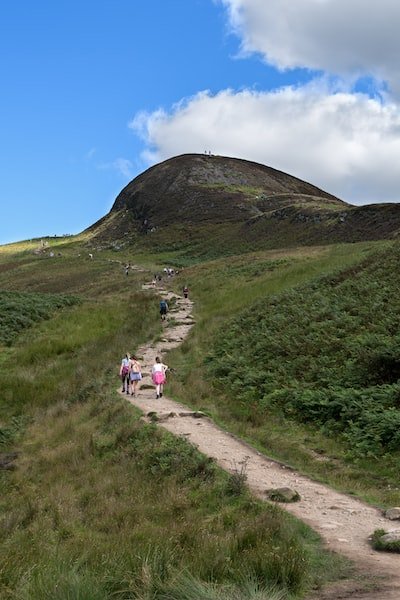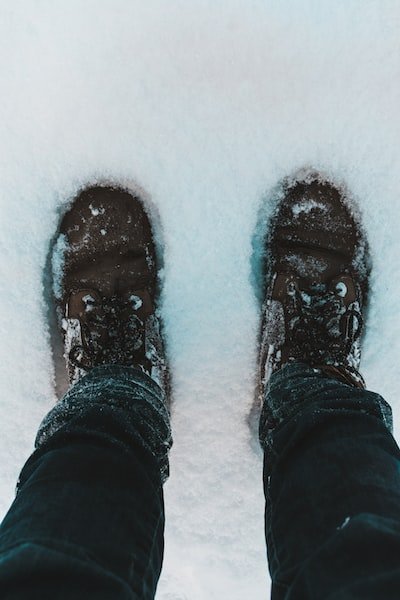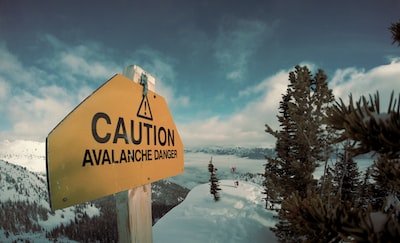The months of December through to February in the UK can be gloomy with damp overcast days and long nights. One of my favourite things to do in this time to lift the cheer is hiking. It is a fantastic opportunity that cost nearly next to nothing and with some really cool benefits both physically and physiologically. In this guide we cover everything you need to know about winter hiking ranging from, what to wear, what to eat, safety tips and many other. Use our table of contents below to navigate yourself to any part of the article you would like to read. We have also linked to some of our other articles that cover some of these topics in greater depth.

Table of Contents
Understanding Winter Hiking
To have a successful winter hike, it’s important to understand the essentials of winter hiking. As temperatures drop and snow begins to blanket the trails, you’ll need extra layers to protect yourself against the cold weather conditions. Knowing the trail conditions is crucial for a safe winter hike, as it can help you prepare for any obstacles or hazards you may encounter. Winter boots with good traction are a great option for hiking in snowy and icy terrain, as they provide stability and prevent slips and falls. Carrying a first aid kit is also essential, as it ensures you’re prepared for any emergency situations that may arise. Lastly, checking the weather forecast beforehand allows you to plan ahead and make adjustments for a successful winter hike.
Why Winter Hiking is Worthwhile
For me the standout benefits of hiking this time of the year is that I get to see nature in a completely different light; on a snowy day even an ordinary bridge can be transformed into a mesmerising sight. And on top of that, I love the peace and tranquillity that is sometimes missing on the busier trails in the summer as hikers make the most of the weather on popular trails. With the ever rising energy prices, the occasional winter hike will also undoubtedly help keep that heating bill a bit lower.

Anticipating Different Winter Trail Conditions
During winter hikes, it’s important to anticipate and prepare for various trail conditions. Deep snow is common during winter, which can slow down your progress. Make sure to allocate extra time for your hike as trail conditions can be more challenging compared to other seasons. Icy conditions are another factor to consider, so wearing hiking boots with good traction is essential for better grip and stability. Additionally, it’s crucial to understand the signs of hypothermia and be prepared for cold weather hiking. Lastly, be cautious of avalanche terrain and avoid hiking in areas prone to avalanches. By being aware of these different winter trail conditions, you can ensure a safer and more enjoyable hiking experience.
Preparing for Your First Winter Hike
Before embarking on your first winter hike, it’s essential to be well-prepared. Having the right gear is a good idea, including warm clothing, winter boots, and winter camping gear if needed. Dressing in layers, starting with a base layer, is a great option to maintain your body’s temperature and keep warm. Don’t forget to carry warm water or hot tea in an insulated water bottle for hydration on cold winter hikes. Additionally, checking trail markers and signs is crucial as winter conditions may make trail navigation more challenging. Lastly, it’s always wise to carry extra food in case the hike takes longer than expected due to winter conditions. With these essential tips, you’ll be ready to tackle your first winter hike with confidence.
Identifying Suitable Winter Trails
When choosing winter trails for beginners, look for well-maintained options that are suitable for winter possibly trails on public lands that allow winter hiking, making sure you have the necessary permits if required. For beginners, it’s a good idea to choose trails with less steep slopes to minimise the challenges. Before heading out, always check the trail conditions and snow conditions to ensure safety. When navigating winter trails, consider using a paper map or GPS device as snow cover may hide trail markers.

Assessing Weather Conditions
It’s essential to assess the weather conditions for a safe and enjoyable experience. Pay attention to the temperature, wind, and precipitation. The cold rain can make winter hiking more challenging, so be mindful of any signs. Additionally, keep in mind the shorter daylight hours during the winter months and plan your hike accordingly. It’s crucial to protect your exposed skin from the cold temperatures by wearing a neck gaiter, gloves, and warm clothing layers. Stay updated on the weather conditions before and during your hike, as they can change quickly.
Creating a Safe Hiking Plan
When creating a winter hiking plan, start by sharing your hiking plan with someone you trust, providing them with details such as your intended trail, start time, and expected return time. This information is crucial for safety and rescue purposes. Additionally, be sure to inform them of any changes in your hiking plan to ensure that you can be located if needed.
Carrying the right essentials is another vital aspect of creating a safe hiking plan for winter adventures. Pack extra layers to keep warm and comfortable throughout the hike. A first aid kit is a must-have in case of any emergencies. Don’t forget to bring water, snacks, a map, and navigation tools to stay hydrated and on track during your hike.
Understanding the essentials of winter clothing is also crucial for a safe hiking plan. Make sure you have appropriate base layers, an outer layer to protect against the elements, a puffy jacket for added insulation, and accessories like gloves, socks, and gaiters to keep your extremities warm. Lastly, staying hydrated is important even in cold weather. Consider carrying a hydration reservoir or hot water for hot tea or chocolate to maintain your body’s temperature.

Ensuring Comfort and Warmth During the Hike
To ensure a comfortable and warm winter hiking experience, it’s important to layer your clothing appropriately. Start with long underwear as a base layer to provide extra warmth during the hike. As an outer layer, opt for a puffy jacket to keep your body heat in and protect yourself from the cold weather. Don’t forget to protect your extremities by wearing extra gloves and warm wool socks specifically designed for winter hiking. To stay warm throughout the hike, carry a thermos of hot tea or warm beverage in an insulated water bottle. Additionally, it’s always a good idea to carry extra fleece layers that you can add or remove depending on the temperature conditions. These additional layers will come in handy in case of extreme cold temperatures.
The Art of Layering for Winter Hiking
When it comes to winter hiking, the art of layering is crucial for regulating your body’s temperature and ensuring your comfort throughout the hike. By layering your clothing, you can easily add or remove layers as needed, adapting to changing weather conditions and exertion levels. Start with a moisture-wicking and insulating base layer, such as wool or synthetic materials, which will keep you warm and dry by wicking away sweat from your skin. Over this, add an outer layer like a waterproof jacket to protect you from cold wind, rain, or snow.
To keep your feet warm and dry, wear warm, insulated socks and boots designed for winter hiking. Pair them with gaiters to prevent snow from getting inside your boots. Additionally, don’t forget to protect your neck and face from the elements by wearing a neck gaiter, especially in extremely cold weather conditions. By mastering the art of layering, you’ll be able to stay comfortable, regulate your body’s temperature, and fully enjoy the wonders of winter hiking.
Importance of Snacks and Warm Drinks
Packaging snacks and warm drinks is a good idea when embarking on winter hiking adventures. In cold temperatures, the body burns extra calories to keep warm, so having snacks on hand provides the necessary energy boost. Trail mix or energy bars are great options as they are packable and easy to consume while on the go. Additionally, carrying warm drinks like hot chocolate, hot tea, or warm water is essential for staying hydrated and maintaining comfort during the hike. These beverages not only provide hydration but also offer a bit of extra warmth and coziness in chilly weather.

Keeping Active to Maintain Body Heat
Taking breaks is necessary when you’re hiking however it is important to think about where and how long for. try and rest in areas protected from the elements if possible and try not to stay static for too long as this will only lead to drop in body temperature.
Types of Winter Hiking Footwear
When it comes to winter hiking, having the right footwear is essential for a safe and enjoyable experience. There are several types of winter hiking footwear that you can consider. Insulated boots are designed to keep your feet warm and dry in cold and wet conditions. They provide insulation and often have waterproof features to protect your feet from moisture. Snowshoes are another great option for winter hiking. They provide better traction and stability when walking on snow and ice. Microspikes can be attached to regular hiking shoes to provide additional traction on icy surfaces. Gaiters are also important to consider, as they cover the lower leg and shoe, preventing snow from entering and keeping your feet dry. Lastly, it’s important to choose socks that are made specifically for winter hiking. These socks provide insulation and moisture-wicking properties to keep your feet warm and dry throughout your hike. So, when preparing for your next winter hike, make sure to invest in the right footwear to keep you comfortable and safe on the trails.

The 10 Must-Haves for Winter Hiking
When embarking on winter hiking adventures, it’s essential to be well-prepared with the right gear. To ensure a safe and enjoyable experience, here are the top 10 must-haves for winter hiking:
- Proper footwear: Invest in waterproof and insulated boots to keep your feet warm and dry, providing maximum comfort and protection on snowy trails.
- Layered clothing: Dressing in layers allows you to regulate your body’s temperature as you hike, preventing overheating or getting too cold. Choose moisture-wicking base layers, insulating mid-layers, and a windproof outer layer.
- Hats, gloves, and scarves: Protect your extremities from frostbite and windburn by wearing a warm hat, insulating gloves, and a scarf or neck gaiter to cover exposed skin.
- Navigation tools: Bring a map, compass, or GPS device to navigate trails accurately, especially when visibility is reduced due to snowfall or fog.
- Sun protection: Even in winter, the sun’s UV rays can still be harmful. Wear sunscreen and sunglasses to protect your skin and eyes from sun damage.
- Emergency supplies: Pack a well-stocked first-aid kit, a whistle to signal for help, a fire starter to keep warm if needed, and an emergency shelter such as a lightweight tent or bivy sack.
Remember, these are just the essentials of winter hiking. Depending on the length and intensity of your hikes, you may need additional gear such as a sleeping bag or a pair of gaiters to keep snow out of your boots.
Recognising and Avoiding Hypothermia and Frostbite
Recognising and avoiding hypothermia and frostbite is crucial when embarking on winter hiking adventures. Knowing the warning signs of these cold-related conditions can help ensure your safety in the great outdoors. Pay attention to symptoms such as shivering, numbness, and discoloration of the skin, as these may indicate the onset of hypothermia or frostbite.
To prevent these risks, dress appropriately with layers of warm clothing, including a hat, gloves, and waterproof boots. Layering allows you to regulate your body’s temperature as needed. Stay hydrated throughout your hike and consume high-energy snacks to maintain body warmth. It’s important to avoid overexertion and take frequent breaks to rest and warm up.
In addition to dressing appropriately and staying hydrated, always carry emergency supplies such as a first-aid kit, signaling devices, and extra food and water. These essentials of hiking are particularly crucial during the winter months when weather conditions can be unpredictable. By taking these precautions and being aware of the warning signs, you can enjoy winter hiking safely and comfortably.
Safety Measures When Encountering Ice and Snow
If Hiking in snow conditions, wearing appropriate footwear with good traction is a must to avoid slipping on icy surfaces. Consider investing in boots designed for winter hiking or add traction devices like microspikes or crampons to your hiking shoes for added stability.
Additionally, using trekking poles can provide extra stability and balance when navigating slippery terrain. They can help distribute weight and reduce the risk of falls. It’s also crucial to be aware of avalanche risks and stick to designated trails, as venturing into unmarked or unstable areas can be extremely dangerous.
Being prepared for changing weather conditions is essential during winter hikes. Dressing in layers is key to regulate your body’s temperature as temperatures can drop quickly. Bring extra warm clothing, including a hat, gloves, and a waterproof jacket, to stay protected from the cold. Don’t forget to pack emergency supplies such as a first aid kit, flashlight, and extra food and water.
Remember to exercise caution and make safety a priority during your winter hikes. By following these safety measures, you can have a great time exploring the winter wonderland while staying safe.

What Should You Do If You Get Lost During a Winter Hike?
If you happen to lose your way during a winter hike, it’s important to stay calm and try to retrace your steps. If that’s not possible, stay put instead of wandering around aimlessly. Utilise any available tools like maps, compasses, or GPS devices. In case you’re without any means of navigation, make noise or use a whistle to signal for help.
Conclusion
In conclusion, winter hiking can be a rewarding and exhilarating experience if you are well-prepared. It offers a unique opportunity to explore nature in its colder, more serene form. By understanding the basics of winter hiking, preparing adequately, ensuring comfort and warmth, and having the essential gear, you can have a safe and enjoyable adventure. However, it is important to be aware of the risks associated with winter hiking, such as hypothermia, frostbite, and getting lost. Always prioritise safety and take necessary precautions to mitigate these risks. With proper planning and knowledge, you can embark on unforgettable winter hiking journeys and create lasting memories in the great outdoors. Stay warm, stay safe, and happy hiking!